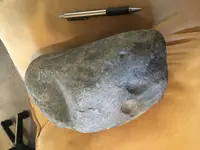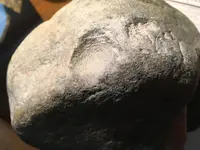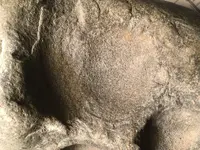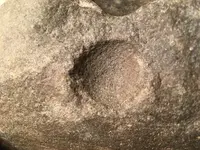You are using an out of date browser. It may not display this or other websites correctly.
You should upgrade or use an alternative browser.
You should upgrade or use an alternative browser.
No Nuts for 5,000 years!
- Thread starter Siwash
- Start date
SportsmanAll
Full Member
- Joined
- Mar 21, 2018
- Messages
- 179
- Reaction score
- 302
- Golden Thread
- 0
- Primary Interest:
- All Treasure Hunting
I don’t notice much pecking or ware marks, I may be wrong but it’s looking pretty natural to me....
flinthunter
Hero Member
Looks like an Omarolluk or Omar for short. I think it is natural.
Looks like an Omarolluk or Omar for short. I think it is natural.
I think you nailed it.
SportsmanAll
Full Member
- Joined
- Mar 21, 2018
- Messages
- 179
- Reaction score
- 302
- Golden Thread
- 0
- Primary Interest:
- All Treasure Hunting
As you said, the thing lacking is the ability to use it efficiently due to it not being flat or easy to work with. I’m not saying it doesn’t look really close, I’m just saying if I found it I would personally rule it as nothing.
Charl
Silver Member
- Joined
- Jan 19, 2012
- Messages
- 3,076
- Reaction score
- 4,772
- Golden Thread
- 0
- Location
- Rhode Island
- Primary Interest:
- Relic Hunting
Many times pitted stones are indeed work tables. And that’s because they are anvil stones, part of the toolkit for lithic bipolar production. Here are a couple of examples of anvil stones:
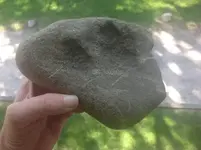
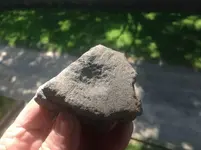
With nutting stones, in contrast, the pits are created first. With anvil stones, the pits result from usage. Nutting stones were apparently made with different size nuts in mind. The reason they are often interpreted as Archaic, at least here in the Northeast, is archaeologists have described what they call “Mast Forest Archaic”, where people made nuts from such trees a staple of their diet.
Here are a couple of nutting stones:
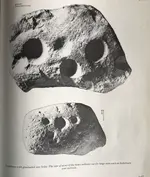
The one thing that troubles me about the stone in this thread is that some pits are positioned in a way that would make it awkward, perhaps impossible, to allow the stone to lay flat for easy use as a nutting stone. The second photo in the initial comment illustrates that problem. Why would a nutting pit have to be positioned for use with the stone positioned on edge? Perhaps the pits are manmade, but, if so, it would seem to be a very inconvenient shaped stone for such usage. I guess it can’t be ruled out, as I see the “on edge” stone is upside down in the photo....


With nutting stones, in contrast, the pits are created first. With anvil stones, the pits result from usage. Nutting stones were apparently made with different size nuts in mind. The reason they are often interpreted as Archaic, at least here in the Northeast, is archaeologists have described what they call “Mast Forest Archaic”, where people made nuts from such trees a staple of their diet.
Here are a couple of nutting stones:

The one thing that troubles me about the stone in this thread is that some pits are positioned in a way that would make it awkward, perhaps impossible, to allow the stone to lay flat for easy use as a nutting stone. The second photo in the initial comment illustrates that problem. Why would a nutting pit have to be positioned for use with the stone positioned on edge? Perhaps the pits are manmade, but, if so, it would seem to be a very inconvenient shaped stone for such usage. I guess it can’t be ruled out, as I see the “on edge” stone is upside down in the photo....
Last edited:
SportsmanAll
Full Member
- Joined
- Mar 21, 2018
- Messages
- 179
- Reaction score
- 302
- Golden Thread
- 0
- Primary Interest:
- All Treasure Hunting
deep non glacier grooves on one side, obvious grinds in a couple of holes, same rock material as Ohio nutting stone, I'm calling it a worktable.
Sounds good. Just giving you our opinions.
newnan man
Gold Member
- Joined
- Aug 8, 2005
- Messages
- 6,742
- Reaction score
- 26,062
- Golden Thread
- 0
- Location
- Beautiful Florida
- Primary Interest:
- Relic Hunting
In certain SE Ohio counties there are creeks loaded with those type of stones. Also some overhang caves have those type of pock marks on their ceilings. Some of the pocks are quite large, others the size of a pencil and everything in between. I think the stone in this thread is natural. Charls post makes that clear.
uniface
Silver Member
- Joined
- Jun 4, 2009
- Messages
- 3,216
- Reaction score
- 2,905
- Golden Thread
- 0
- Location
- Central Pennsylvania
- Primary Interest:
- Other
re. lying flat, anything will if shoved into soft dirt deep enough.
Siwash
Jr. Member
- Joined
- May 31, 2018
- Messages
- 87
- Reaction score
- 85
- Golden Thread
- 0
- Primary Interest:
- All Treasure Hunting
- #13
Thread Owner
The location suggests this; found buried at the edge of a small flowing creek. The creek is spring-fed, with a nearby 3-ft. bedrock "waterfall" (small, not the Niagara!). Different rock material than that nearby. The adjacent land has one or two other small creeks/streams flowing into a moderate size river; the land is undulating and would be/much is very wooded. The stone's holes aren't all regularly circular but the larger one has been mashed on in different ways. It's a fine-grained, harder stone.
quito
Silver Member
- Joined
- Mar 31, 2008
- Messages
- 4,626
- Reaction score
- 4,844
- Golden Thread
- 0
- Location
- south dakota
- Detector(s) used
- good eyes
I find them often on sites I hunt. Omar for sure.
Once in a while one that’s been utilized is found.
have you even bothered to google Omar’s?
http://www.geo.mtu.edu/KeweenawGeoheritage/BeachStones/Omars.html
Once in a while one that’s been utilized is found.
have you even bothered to google Omar’s?
http://www.geo.mtu.edu/KeweenawGeoheritage/BeachStones/Omars.html
quito
Silver Member
- Joined
- Mar 31, 2008
- Messages
- 4,626
- Reaction score
- 4,844
- Golden Thread
- 0
- Location
- south dakota
- Detector(s) used
- good eyes
I also noticed there isn’t a hole on your piece that shows any polish in the bottom.
just sayin.
just sayin.
Similar threads
- Suggestion
- Replies
- 19
- Views
- 1K
Users who are viewing this thread
Total: 1 (members: 0, guests: 1)

